The Gift of South Dakota
Subscriptions to South Dakota Magazine make great gifts!
Subscribe today — 1 year (6 issues) is just $29!
Boss Cowman’s Own Words
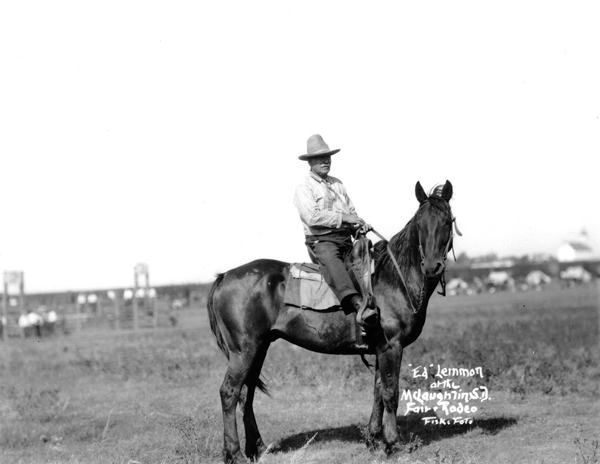 |
| Ed Lemmon had several mishaps on horseback, but none that kept him out of the saddle for long. |
George Edward Lemmon was 13 when he went to work for the Bear Creek Ranch in Cheyenne, Wyo. He lived in the saddle for much of the next 40 years, holding down every job in the cattle business, from trail hand to running a ranch bigger than Rhode Island. Some said he rode over every square foot of West River, and if that was an exaggeration it wasn’t by much. The son of a railroader, he became one of the most respected cattlemen of his generation.
Books have been written on his exploits — most notably, Boss Cowman by Nellie Snyder Yost — and he is referenced in every respectable history book on South Dakota and cowboy life. But a 400-page book, The West as I Lived It, tells Lemmon’s story in a refreshingly blunt and first-person style. It is nothing more or less than a collection of weekly newspaper columns the old cowboy wrote for the Belle Fourche Bee from 1932 to 1936, compiled into a book by Belle Fourche historian Phyllis Schmidt.
“Writing the stories gave him a chance to relive the many memories he had of his friends and events of the good old days,” Schmidt observed in the introduction. Schmidt, who serves as curator of the Grand River Museum, spent three years on the project. Her result is a history of cowboy life quite unlike anything else that has been published — recorded in an earthy and colorful prose that only a real, wise cowboy could achieve.
“In the cow business one is exposed to all kinds of dangers and hardships,” wrote Lemmon in one column. His life was a case in point. A horse fell on him when he was 17, crushing his right leg above the knee and landing him in bed for four months. Less than a year later, he suffered an even more serious mishap while he and another hand were training a horse.
“Tom [McCumskey] was riding a young mare…while I rode [alongside] with a rope around my 1,200 pound mount’s nose. After running about 200 yards both flew the track, which was a wagon road, each bolting outward. As we pulled them inward they clashed together with terrific force, piling Tom’s mount up to a heap and killing my mount on the spot, and crushing my partially healed leg in a similar manner as the year before, and rendering me unconscious for an hour. I was rendered a cripple for life, for besides the breaks, rheumatism set in, drawing my defective leg all out of shape.”
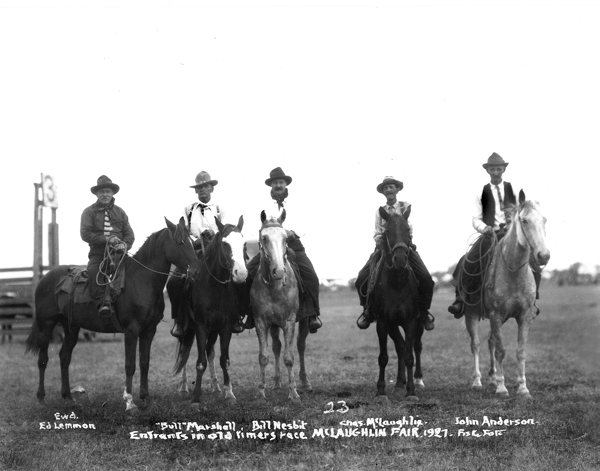 |
| Lemmon and other pioneers competed in an old-timers race at a 1927 fair in McLaughlin. |
Over the years he was knocked unconscious several more times and broke numerous bones, but Lemmon was nothing if not tough. When he busted his collarbone, “I took up my duties the next morning with my right arm in a sling, which necessitated roping my mounts with my left hand.” Another time his horse spooked and took an ill-advised leap, causing them to roll down a steep embankment together. When Lemmon returned to camp, his partner “noticed my next to little finger on my right hand swinging loosely and out of place. So he had one of the boys hold my right arm while he pulled it back, and really, this was the most severe punishment I ever underwent. I came near fainting, and the knuckle is still low.”
As a ranch hand, Ed Lemmon drove longhorns up from Texas for two decades, until the railroad’s spreading tentacles made such epic treks unnecessary. He passed through the rowdy cow towns of Kansas, patrolled by Bat Masterson and Wyatt Earp, and likely never ran afoul of either, for he avoided the trail hand’s bane, liquor. Lemmon never drank anything stronger than lemonade.
Once up north, the cattle were fattened over winter on ranges along the Republican River, then in the Platte River country of central Nebraska. In contrast to the trail drives, a staple of Western mythology and popular entertainment, no screenwriter ever penned a script about tending “beeves” over winter, though they might have in Lemmon’s case.
Lemmon was working the Rush Creek Ranch near Sidney, Neb., when Red River Red, a grizzled veteran of the frontier, “covered with scars from both gun and knife wounds… which he displayed apparently with much glory,” showed up on foot, looking for a job. Ranch owner George Green took Red on, and the three men settled in for the winter. When they divvied up the housekeeping chores, most of the cooking duties fell to Lemmon. “I prided myself on keeping the kitchen and cooking paraphernalia in neatness, especially the drying cloths,” recalled Lemmon in the Belle Fourche Bee.
“One morning I forgot to fry [Red’s] bacon, and he rather peevishly jumped up, grabbing the slab of bacon and knife and slicing half a dozen slices of bacon,” wrote Lemmon. “He had previously slammed the skillet on the stove rather far back and when he had the bacon ready he grabbed the drying cloth instead of the dish rag with which to handle the hot receptacle. When I drew his attention to the fact that he should use the dish rag instead of the drying cloth he flared up, saying he would not be dictated to by me. Accusations flew back and forth across the breakfast table and finally our epithets became so heated we both started to draw our six-shooters.”
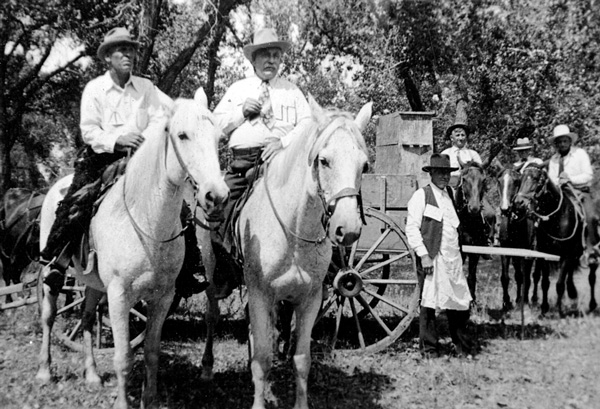 |
| Whenever West River cowboys gathered for real or ceremonial purposes, Ed Lemmon (second from left) was eager to participate. |
Green trumped their pistols with his Winchester rifle and defused the situation, but Red wasn’t about to let the matter drop. Later that day the three men journeyed to nearby Lodge Pole, and along the way Red told Green that he meant “to get a row going” with Lemmon and kill him. To forestall him, Green enlisted Tex Matthews, “a gunman of the first magnitude,” to have a word with Red. Matthews’ persuasive powers, and the six-gun hanging on his hip, convinced Red that his health would be best served by boarding the next train for Cheyenne. Thus the drying cloth incident, a little-known epic of the west, ended peacefully.
The Fort Laramie Treaty of 1868 brought an end to Red Cloud’s War and established the Great Sioux Reservation. In exchange for peace and renouncing claim to all lands outside said reservation, the tribes accepted a number of government promises, including a guarantee to provide “one pound of meat and one pound of flour per day” to every member who settled there. At a stroke, this created a demand for 30,000 cattle per year.
Major Seth Mabry, a Texan who earned his rank serving the Confederacy, was one of those who recognized the business opportunity. Lemmon was working for Mabry in 1877 when Mabry contracted to deliver 800 head from his Platte River spread to the Red Cloud and Spotted Tail agencies in northern Nebraska.
For whites on the Northern Plains, this was an unsettled time, just a year after the Seventh Cavalry’s annihilation at Little Big Horn; even well settled areas were thought to be at risk, and every Indian was viewed as a threat. A rider overtook Mabry’s crew with orders to send a hundred cattle 160 miles further on to an Army encampment on the Cheyenne River; it was not a journey to be taken lightly.
Though Lemmon was just a month past his 20th birthday, the youngest of three men tasked to get the Army its beef, he was put in charge of the detail. “I can’t recall I felt… the least worried about the outcome of that expedition,” wrote Lemmon many years later. His confidence was well founded. The Army got its beef without losing a man or an animal.
The Sheidley brothers, William and George, appreciated Lemmon’s experiences working cattle on the open range and his ability to handle men. When the Kansas City buggy manufacturers decided to enter the cattle business in Dakota Territory, they hired the 23-year-old Lemmon as their foreman. Ed, as he preferred to be called, settled on the Flying V Ranch, at the confluence of French Creek and the Cheyenne River in the Badlands.
After gold was discovered in the Black Hills, within the Great Sioux Reservation’s boundaries, it was only a matter of time before the Indians lost what had been granted to them in perpetuity. The government relieved them of the great wedge of land that lay between the Cheyenne and Belle Fourche rivers in 1877. The Flying V lay just within this Black Hills cession, but no fences kept the cattle confined. During the winter months especially, cattle were allowed to drift and forage where they could, even on the surrounding, unceded Indian lands.
“We were all trespassers,” said Lemmon of himself and the stockmen whose herds grew fat on grass that belonged to others, but knowledge of the law didn’t deter him from taking advantage of the situation.
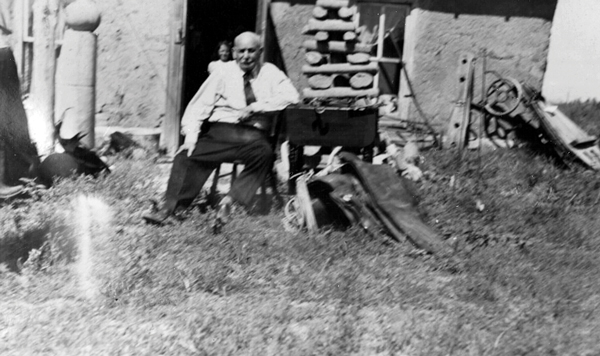 |
| In his later years, Ed Lemmon transitioned from brash young cowboy to an elder in the town that bears his name. |
As cattle from different herds drifted over winter, they inevitably mixed together. That made necessary one of the great operations of the era, the spring roundup. In late winter notices were published in stock papers about gathering points, usually the heads of streams, and in mid-May the general roundup began. Wagons from every outfit in the area were loaded with supplies and dispersed across the prairie, trailing a dozen or more cowboys. Each hand needed eight to 10 horses, for they would be riding hard, for a month or more, driving cattle that were spread over thousands of square miles to collection points.
Every roundup was an event, but for Ed Lemmon and other old-timers the spring of 1897 stood out from all others. That winter had been especially hard. Early season storms coated the prairie in glistening ice, then blizzard followed upon blizzard, burying the grass and making it impossible for cattle to graze. From northern and central South Dakota, thousands of cattle drifted south in search of feed. “There was hardly an animal left north of the Cheyenne River,” wrote Lemmon, and getting them back promised to be a monumental undertaking.
From the Nebraska state line to Fort Pierre, cowpokes drove the wayward cattle toward Peno Flat on the Bad River. George Jackson was supposed to oversee the sorting operation, but when he sized up the job – 45,000 cattle, 24 wagons, 500 men, 5,000 saddle horses — he asked Lemmon to take over. Though he was in charge, Lemmon didn’t leave the grueling work of separating the cattle to others. Such was not his style. He personally cut 900 animals in a single day, a record never equaled, and cemented his reputation as a cowboy’s cowboy.
Ed Lemmon was made general manager of the Sheidley Cattle Company, with an ownership stake, in 1891. As part of his new duties he made his first cattle-buying trip to Texas in the spring of that year. “I naturally thought to look the part of a wealthy cattle buyer,” he wrote, “so I borrowed a gold watch and chain from our range boss, and a handsome gold ring from one of our sympathetic boys.”
Lemmon might have lacked the accessories for his new position, but most assuredly not the attitude. On that first trip south he arranged to ship 5,000 cattle back to Belle Fourche, the nearest railhead to Sheidley’s home place on the Moreau River. He wired ahead to foreman John Currington for an outfit to meet the initial consignment, only to have the Sheidley company president, R.C. Lake, countermand the orders. Several thousand cattle were left untended for two days.
When Lemmon arrived in Rapid City on the next train and the mix-up was discovered, there were “hot words flying, to be sure.” Lake was supposed to give Lemmon cash to pay off the shipper, “and while we were jangling over the matter the train had gotten under motion,” wrote Lemmon. “I let [Lake] trot along beside the train near… 100 yards, panting like a lizard, for he was a 200-pounder and office soft. All the time he was trying to poke the roll of bills to me through the car slats. Finally he says, ‘If you want this money you better take it for I am about to drop in my tracks.’ It was not only R.C. Lake that got a bawling out but Currington. I gave them both to understand that I was running that end of the business, and never again did Mr. Lake change any of my orders in any manner.”
Another indication of Lemmon’s rising status came in the winter of 1892 when he gathered in Rapid City with other notables of the Dakota cattle business, including James “Scotty” Philip, and founded the Western South Dakota Stock Growers Association. He paid his $5 membership dues, and when the group formally organized Lemmon was elected to the executive committee, a seat he held for 23 years. “In the early days of the organization my name was often mentioned as president,” he wrote, “but as I could not address an audience, I most emphatically declined.”
Among the WSDSGA’s foremost concerns was the prevention of cattle rustling. To that end they hired a range detective, Joe Elliot, one of a notorious group of gunmen previously employed by the Wyoming Stock Growers Association to rid the Powder River area of rustlers. They undertook the task so vigorously that President Harrison was forced to declare martial law in the region and dispatch Army troops to send Elliot and company on their way.
“There is no evidence Elliot ever drew his gun in anger while working for the [WSDSGA],” wrote Bob Lee and Dick Williams in Last Grass Frontier, but the association obviously knew what they were getting when they hired him. “[Elliot] always gave the other fellow the first shot,” wrote Lemmon. “That way he always had the law on his side when he dropped him.”
In 1893 Lemmon sold his share of the Sheidley Cattle Company and went into partnership with Richard Lake and Thomas Tomb. At its peak around the turn of the century, Lake, Tomb & Lemmon employed 300 men and ranged up to 53,000 head along the Moreau and Belle Fourche rivers.
Lemmon and his partners were operating on the scale of the barons of old, but the cattle business as it existed when he started was gradually passing away. In 1887 the Dawes Act effectively whittled the Great Sioux Reservation down yet again and defined western South Dakota’s Indian reservations more or less as they are today. Outside those boundaries the land was opened to homesteaders, which complicated life for the big cattle operators by pock marking the open range with small holdings. The cattle kings appealed to Congress for a measure to allow leasing of the last large tracts of unencumbered land on the Indian reservations.
Murdo MacKenzie of the Matador Cattle Company and Burton “Cap” Mossman of the Hanson Land and Cattle Company, who already controlled vast swaths of land from New Mexico to Saskatchewan, obtained leases of a half-million acres each on the Cheyenne River Reservation. Lemmon proved equally adept at working the system. With the assistance of South Dakota’s Senator Alfred Kittredge, he wrangled an invitation to the White House in 1902 to discuss leasing grass on the Standing Rock Reservation. President Theodore Roosevelt had owned a spread in North Dakota’s Badlands during the 1880s, and though he was an absentee owner, he often participated in spring roundups and fancied himself a rugged cattleman of the West. Lemmon brought the president up to date on conditions in the Dakotas, and the schmoozing paid off.
“The interview resulted in Roosevelt’s order to the Secretary of the Interior to approve my lease of 865,529 acres on the reservation,” wrote Lemmon. “I fenced it with a three-wire fence … giving me 270 miles of fence and cross fence. It was said by the National Livestock Association to be the largest pasture in the world, being larger than the state of Rhode Island.”
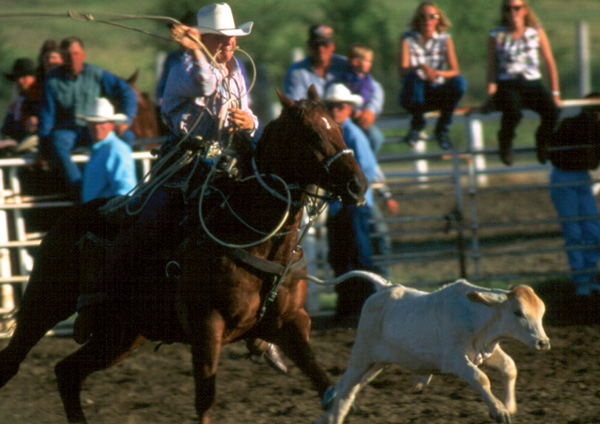 |
| The town of Lemmon started the Boss Cowman Rodeo in 1971. |
Lemmon returned from Washington in early May to what he called a “most pleasant” experience. “I was crossing my immense lease for the first time since it was awarded to me,” he wrote. “As I approached Leaf-On-the-Hill, which is about 12 miles northeast of the present city of McIntosh, I drove on top of the very highest pinnacle and stopped my team, stood up in my buggy, drew a long breath of fresh air and shouted to the universe that I was Lord of all. I surveyed for as far as my eyes could reach. I could not see the end of my domain … and when fenced, no man could trespass on me as had been the case on the open ranges I had just occupied.”
Since his days as manager of the Sheidley Cattle Company, Lemmon had stayed part of every winter in Chicago, where most of the cattle raised in Dakota were sold. While there he lodged at the Great Northern Hotel, and rubbed elbows with some of the city’s notables; among them was R. M. Culkins, general development director of the Chicago Milwaukee & St. Paul Railroad.
CM&SP’s line from Aberdeen reached the Missouri River in 1900, and the company was looking to extend it westward. After a number of surveys, the company still couldn’t settle on a route. Culkins asked Lemmon’s advice, for he knew that country as well as any man, and the next day Lemmon returned with a government map of the Standing Rock Reservation he just happened to have along. A red pencil line marked a route from the mouth of the Grand River, present-day Mobridge, to Reeder, N.D., which incidentally skirted the Lake, Tomb & Lemmon holdings.
“As soon as I was advised that the proposed route had been found satisfactory… I got busy at once and purchased several hundred acres of land along the proposed route, the purpose being to ‘coppe’ a good town site not far from the reservation line,” wrote Lemmon.
Such was the stuff of western dreams: Lake, Tomb & Lemmon got a railroad connection close to its holdings, which helped the operation immensely, and Lemmon profited by knowing beforehand exactly where the rails would run. Last but not least, Culkins agreed to name a town on the new line after Lemmon.
Lemmon acquired nearly 1,300 acres along and near the CM&SP line with so-called railroad “script.” Scripting was a malodorous scheme engineered by Frederick Weyerhaeuser of the Santa Fe Railroad, which enabled him to exchange some of the line’s worthless land grant acres for other, more valuable homestead land in the West. When the prime timberland Weyerhaeuser wanted was all gone, “or he became ashamed to take more,” in Lemmon’s words, Weyerhaeuser sold his remaining rights.
“Every acre I scripted made good money,” wrote Lemmon. Some in north Lemmon bought for about $8 an acre, later sold for $100; a tract of 163 acres in and around the town site that was resold to the railroad brought $3,260, and Lemmon saved a corner lot for himself.
Lemmon’s first choice as a town site was about 4 miles east of present-day Lemmon, but there was a problem: it was in North Dakota, which was then a dry state. “In order to make [Lemmon] a real boom town, the saloon with its attendant evils would have to be tolerated,” he wrote. Lemmon ended up locating what he jokingly called “the new El Dorado” astride the state line, in hope that it would become the county seat for both Perkins County, S.D., and Adams County, N.D. Lemmon ended up being neither, but the town nonetheless proved “a hummer,” wrote Lemmon. “It was wide open and wild and wooly, however, not a single life was lost, though fights of all kind were frequent and furious.”
In 1908, after four decades in the cattle business, Ed Lemmon sold his interest in Lake, Tomb & Lemmon. He was 51 and ready for a second career. Lemmon founded and served as president of banks in Lemmon, Davison and Meadow, among other business ventures. When Perkins County was organized in 1909, he became one of its first commissioners; he also served as a commissioner for Adams County, N.D. How he could simultaneously be considered a legal resident of both states has not been recorded, and he didn’t explain in his newspaper columns 21 years later. Most likely no one was so impolitic as to mention it.
“Dad” Lemmon, as one and all referred to him, was a familiar figure around “his” town — familiar enough that citizens knew it was best not to be anywhere nearby when he got behind the wheel of his Model T. “He’d rev the engine up to 4,500 rpm, you could hear it all over town, then drop the clutch,” recalled one old-timer. “He went through a lot of clutches.” At some point Lemmon moved out of his house and into the Yellowstone Hotel. Each morning he would come downstairs, wind his engine to beyond its limit, back up at full speed with nary a glance behind him, make “a bootlegger turn” and cross the street to park in front of the cafe.
He drove his car like he rode his horse, according to the Lemmon town history. On the wrong side of the street. Over hills. Into gullies. His automobiles repaid the abuse by getting stuck numerous times, and on one occasion, the car ran over Lemmon while he was cranking it. The mishap broke his left shoulder blade and threw it out of place, where it remained for five months, “before I went to the Aberdeen hospital and had it broken down and silver wire stitched in place.”
In 1941, four years before Ed Lemmon passed away at the age of 88, Life magazine featured South Dakota in one of its famous photo essays. The photographer found Lemmon on Main Street, dapper in a white shirt and tie, but also ungainly, with his right leg misshapen and foot twisted inward; with the aid of his gnarled cane he managed to stay upright, but just. Lemmon was in the town he founded, among people who knew and loved him, but he wasn’t truly home. That was beyond the end of town, in the grass, endlessly shifting in the breeze.
Editor’s Note: This story is revised from the March/April 2008 issue of South Dakota Magazine. To order a copy or to subscribe, call (800) 456-5117.




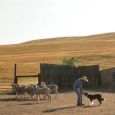
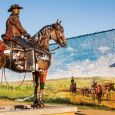

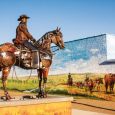


Comments
Uncle Ed's older brother Hervey was no slouch in the cowboy world, either, although he died at the young age of 33, leaving one child, my grandmother. The two men truly were a vital part of the Age of the Cowboys.
Thank you for your interest in Uncle Ed and all things South Dakota.